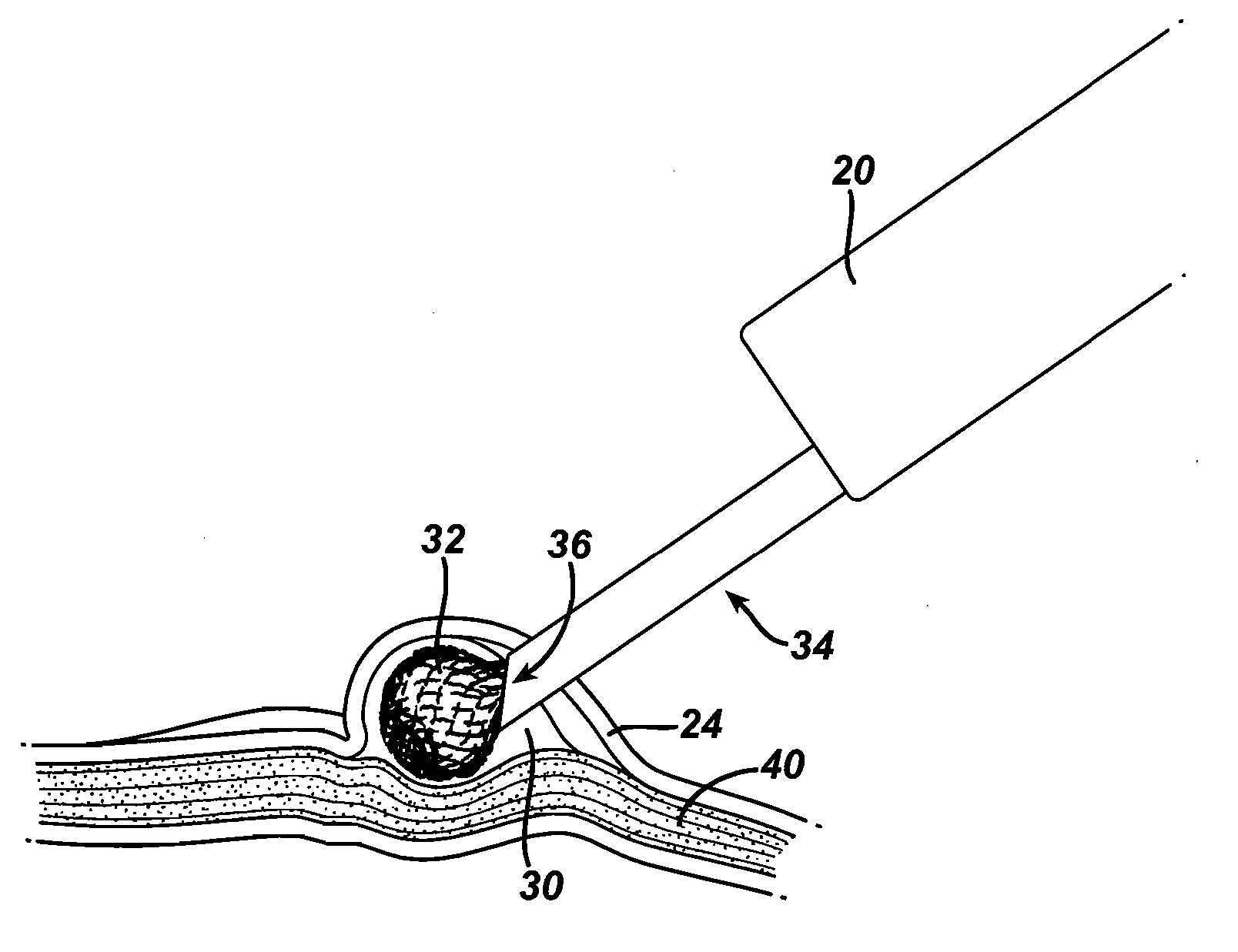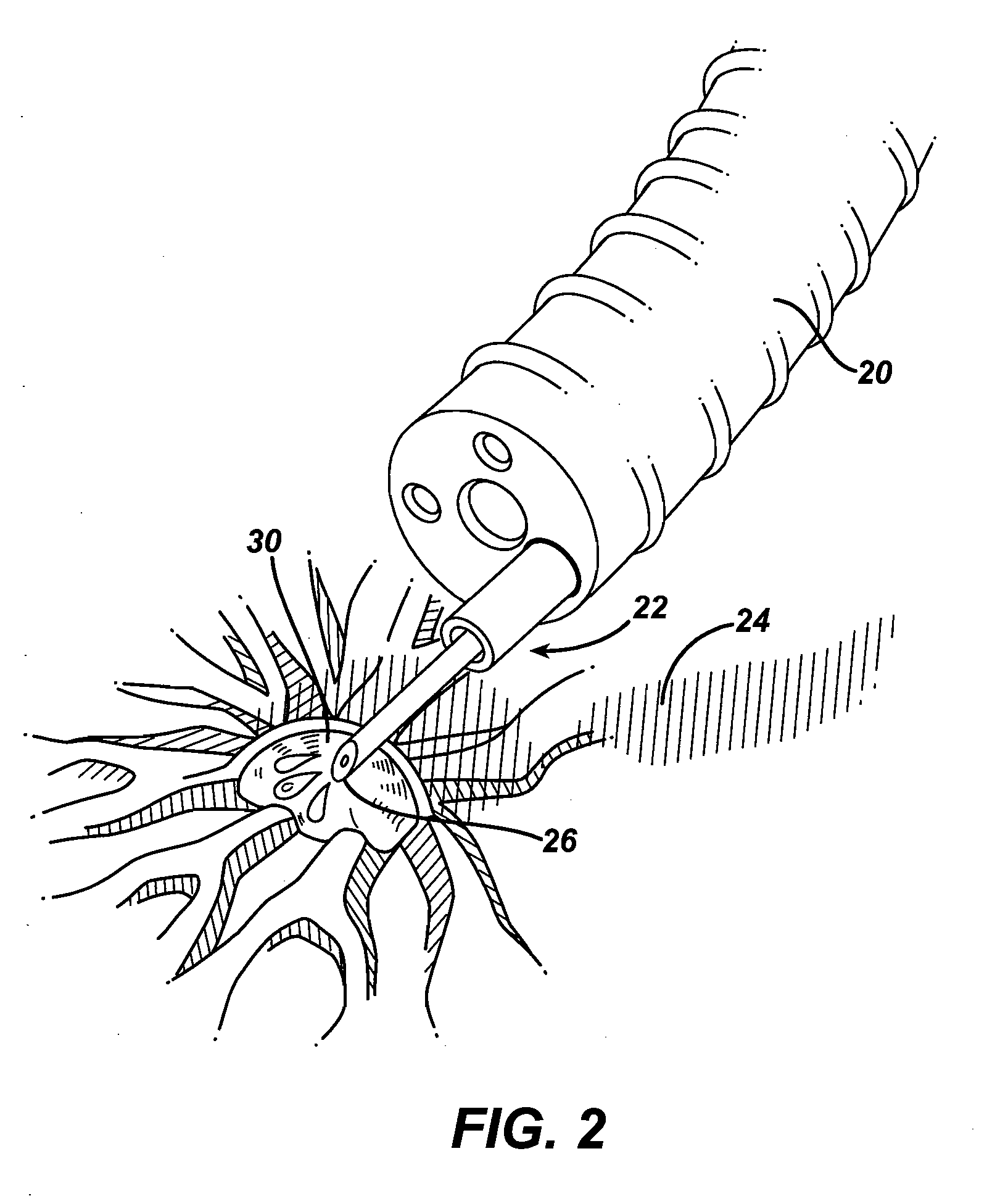Methods and implants for inducing satiety in the treatment of obesity
a technology of satiety and obesity, applied in the field of obesity surgery, can solve the problems of high risk of associated health problems, affecting the personal quality of life of individuals, and contributing significantly to morbidity and mortality
- Summary
- Abstract
- Description
- Claims
- Application Information
AI Technical Summary
Problems solved by technology
Method used
Image
Examples
first embodiment
[0030]FIG. 4 shows a first embodiment for an implantable device of the present invention. In this embodiment, the device comprises an expandable stent 32 composed of Nitinol, or another type of self-expanding, biocompatible material. In this embodiment, stent 32 is passed through a needle lumen in a compressed form, and then expanded into a spherical shape once implanted within the gastric wall. As shown in FIG. 5, to implant stent 32, second needle assembly 34 is passed through endoscope 20. The sharpened tip 36 of the needle assembly is maneuvered into contact with the mucosal layer 24 of the stomach at the location of bleb 30. Tip 36 of the needle pierces mucosal layer 24, so as to position the distal opening of the needle lumen inside of bleb 30. With needle tip 36 between mucosal layer 24 and muscularis layer 40, stent 32 is passed out of the needle lumen and into the pocket formed between the cavity layers. As stent 32 exits needle 34, the stent expands into a ball-like shape....
third embodiment
[0034]FIG. 14 shows a third embodiment for an implantable device in which the device comprises a length of thin, flexible material such as, for example, a biocompatible metal wire 50. As in the embodiments above, wire 50 may be inserted via needle assembly 34 into the bleb 30 formed between the mucosal and muscularis layers. The tip of needle 34 penetrates the mucosal layer to provide an opening for injecting wire 50 into bleb 30. As the length of wire 50 is passed into the gastric wall, as shown in FIG. 15, the wire is encircled about within bleb 30 to create a bunching effect, and thereby form a three-dimensional implant of increased spatial size. The disoriented arrangement of the encircled wire 50, shown in FIG. 16, inhibits migration of the wire within the gastric layers to maintain the position of the implant. Wire 50 may be formed of Nitinol, titanium, or another type of semi-flexible, biocompatible material. As in the previous embodiments, a plurality of wire lengths 50 may ...
fourth embodiment
[0035]FIG. 17 shows a fourth embodiment for an implantable device in which the device comprises a molly bolt 54. Bolt 54 has a compressed shape, shown in FIGS. 18A and 19A, during entry through needle assembly 34 and mucosal layer 24. As bolt 54 is released into bleb 30, the sides of the bolt expand outward, as shown in FIGS. 18B and 19B. Once bolt 54 is fully released from needle assembly 34, the bolt assumes a maximum spatial capacity, as shown in FIGS. 18C and 19C. The expanded size of bolt 54 within bleb 30 allows the bolt to deform the surrounding areas of the cavity wall. A ring of bolts 54 may be formed around the antrum, as shown in FIG. 20, to produce deformation of the gastric layers about the perimeter of the cavity.
[0036]As described above, the implant devices of the present invention can vary as to shape and composition, with the goal that the implant interferes with the contraction of the longitudinal and circular gastric muscles during digestion. The devices' interfer...
PUM
 Login to view more
Login to view more Abstract
Description
Claims
Application Information
 Login to view more
Login to view more - R&D Engineer
- R&D Manager
- IP Professional
- Industry Leading Data Capabilities
- Powerful AI technology
- Patent DNA Extraction
Browse by: Latest US Patents, China's latest patents, Technical Efficacy Thesaurus, Application Domain, Technology Topic.
© 2024 PatSnap. All rights reserved.Legal|Privacy policy|Modern Slavery Act Transparency Statement|Sitemap



